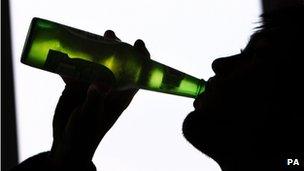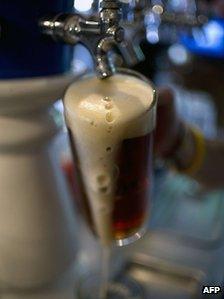The return of the Indian Pale Ale
- Published

Experts say India is not a beer-drinking country
"A mug of ale please," calls Kanishk Goswami across the solid wood bar-top.
Arsenal and other English-football team logos on the walls add to the atmosphere.
The barman returns with a large glass tankard of brown ale.
Two hundred years since English brewers started shipping strong, extra-hoppy beer to colonialists on the subcontinent, India Pale Ale (IPA) is making a tentative comeback here - in a handful of microbrewery pubs emerging in Gurgaon, the fast-growing business hub on the edge of Delhi.
Its main customers so far are the vanguard of the new thrusting India - people like Mr Goswami, a corporate headhunter who set up his company's London operation and got a taste for British beers while there.
"Honestly, that tastes so good," he smiles after his first gulp of IPA. "It's not 100% but 95% spot on."
Most of the beer drunk in India is lager, with the market dominated by brands like Kingfisher.
Minority taste
Even then it's a minority taste. More Indians drink locally-made whisky, or imported scotch for those who can afford it.
There is also a huge business in unlicensed and often poisonous hooch sold to the poor, which claims many lives each year.
Traditionally alcohol has been frowned on - its sale is still banned on several national holidays and four states remain officially dry.
But with changing attitudes and more money around, there is an appetite for new tastes - specially among India's burgeoning middle classes in hard-charging places like Gurgaon.
It is Downtown's owner Vikas Sachdeva, a former General Motors executive, who came up with the idea to start making what he calls "genuine" India Pale Ale.
Inside the bar, you could be anywhere - with Western music videos pumping from the speakers and screens.

India is seeing an explosion of micro-breweries
It is popular with the many younger Indians working in Gurgaon, for companies that include Google, as well as with expats.
Other microbreweries have focused on Belgian-style wheat beers and traditional lagers.
Together with his in-house brewer Gagan Jain, Mr Sachdeva used the internet to find recipes and get advice from other brewers to make what they call "Corporate ale".
Mr Sachdeva also spent around $200,000 (£126,006) importing the chrome-plated fermenting tanks and other equipment which dominate the entry.
They still mostly use imported hops but "it's 100% Indian water", laughs Mr Sachdeva.
It's weaker in alcohol than the IPA of colonial times - which, it's thought, was made stronger to survive the long sea journey from Britain.
Instead of the warm beer British drinkers prefer, here in the Downtown bar IPA is served deep-chilled in a frozen glass - a refreshing necessity with Gurgaon's August bath-like humidity.
"With your weather," jokes Mr Goswami, "your hand would stick to the glass".
Sceptical
But word of the new Indian ale is spreading, it seems. The next two punters we find sipping it turn out to be the owners of another Gurgaon microbrewery.
They deny they are spying on the opposition. "We just came to chill out," says one unconvincingly.
But will the colonial associations of any beer called IPA hold it back?
It is not an issue for any of the drinkers in Downtown - most of whom didn't even know its past.
But commentator and drinks writer Bhaichand Patel is sceptical about it taking off.
"Frankly, India is not a beer-drinking country," he says.
"Really we drink spirits, and when the evening comes we go for the whisky."
But he adds that with India's huge population "even 1% drinking beer" would be a huge market.
Microbrewery pubs are still a new thing in India. At the moment, Mr Sachdeva is only allowed to sell his beer on the premises under his license.
And established brewers like Kingfisher are unlikely to welcome the competition.
But Mr Sachdeva has big ambitions - to start exporting his ale to the UK - "back to where it came from".
So British brewers of IPA might be facing competition - from the real thing.